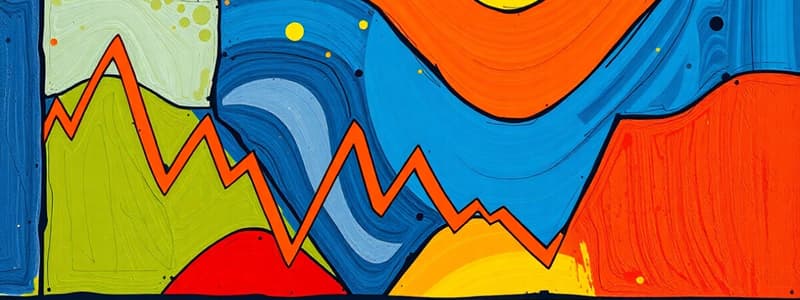Podcast
Questions and Answers
Which of the following events marked the beginning of the Great Depression?
Which of the following events marked the beginning of the Great Depression?
During the Great Depression, the value of stocks dropped significantly in a short period of time.
During the Great Depression, the value of stocks dropped significantly in a short period of time.
True (A)
What is the term used to describe the government's policy of minimal intervention in the economy?
What is the term used to describe the government's policy of minimal intervention in the economy?
Laissez Faire Economics
The New Deal, implemented by Franklin D. Roosevelt, focused on three main objectives: ______, ______, and ______.
The New Deal, implemented by Franklin D. Roosevelt, focused on three main objectives: ______, ______, and ______.
Signup and view all the answers
Match the following events or figures with their corresponding descriptions:
Match the following events or figures with their corresponding descriptions:
Signup and view all the answers
Flashcards
Stock
Stock
Part ownership of a company that can be bought or sold.
Black Tuesday
Black Tuesday
The stock market crash on October 19, 1929, leading to major losses.
The New Deal
The New Deal
Government programs by FDR in 1933 to revive the economy using all resources.
Keynesian Economics
Keynesian Economics
Signup and view all the flashcards
3Rs of The New Deal
3Rs of The New Deal
Signup and view all the flashcards
Study Notes
Stock Market Basics
- Stock represents partial ownership in a company.
- Stockbrokers facilitate stock buying and selling for investors.
- Buying stock "on margin" involves borrowing 10% of the purchase price.
Black Tuesday (October 19, 1929)
- Steep stock market decline (40% loss in a few days).
- Investors faced choices: sell or hold onto stocks.
- Stock value plummeted further by 90% by 1932.
Revenue vs. Market Value
- Companies' revenue differs significantly from their market value (e.g., Facebook, Apple).
- Facebook, with $1.5B revenue, had a $100B market value upon its IPO.
- Apple, with $365B revenue, had a $2,600B market value.
Economic Cycles
- Economic performance fluctuates through peaks (best), recessions (downward trends), and recoveries (returning to peak levels).
Causes of the Great Depression
- Overproduction: Excess goods led to falling sales.
- Limited purchasing power: Wage cuts and layoffs reduced consumer spending.
- Downward spiral: Reduced demand decreased production, leading to further layoffs and reduced spending.
- Primary products: Dependence on agricultural and resource-based industries varied by country.
- High tariffs: Trade barriers hampered economic growth globally.
- Buying on credit: Excessive borrowing contributed to unsustainable spending levels.
The New Deal
- The Great Depression severely impacted both the U.S and Canada in the 1930's.
- In the U.S., Herbert Hoover was replaced by Franklin D. Roosevelt (FDR).
- In Canada, Mackenzie King was replaced by R.B. Bennett.
- The New Deal (U.S.) aimed to boost the economy through government intervention, contrasted with the laissez-faire approach.
- Key initiatives targeted relief, recovery, and reform (3Rs).
- Governmental bailouts often lead to inflation.
- Programs included relief camps, soup kitchens, social safety nets (minimum wage, maximum hours, accident health insurance, pensions, unemployment insurance), and the establishment of the CBC (Canadian Broadcasting Corporation) in Canada.
- Some New Deal initiatives (e.g., social programs) were successful in the U.S. but not fully adopted in Canada.
The Bright Side of the Depression
- Deflation benefitted those with jobs, allowing them to buy more for less.
- Popular entertainment offered distractions, such as the film "The Wizard of Oz", reflecting the hardship facing citizens across the globe.
Studying That Suits You
Use AI to generate personalized quizzes and flashcards to suit your learning preferences.
Description
Explore the fundamentals of the stock market, including ownership, market value, and the impact of economic cycles. Understand historical events like Black Tuesday and the causes of the Great Depression. This quiz will test your knowledge of key concepts and terms in finance and economics.




